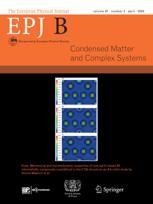Thin quantum wires work better with less insulating coatings
New theoretical analysis considers cases where the electrons are allowed to exist beyond the boundaries of semiconducting quantum wires – with important implications for their performance.
New York | Heidelberg, 19 April 2022
 Thin, semiconducting wires have attracted much recent attention in physics – both in experiments and theoretical analysis. Named ‘quantum wires,’ these structures are often coated in insulating materials, and several previous studies have now explored how the mismatch between the insulating properties of both materials can influence their performance. Through new analysis published in EPJ B, Nguyen Nhu Dat and Nguyen Thi Thuc Hien at Duy Tan University, Vietnam, show that thinner wires with less insulating coatings can improve the mobility of the electrons they carry.
Thin, semiconducting wires have attracted much recent attention in physics – both in experiments and theoretical analysis. Named ‘quantum wires,’ these structures are often coated in insulating materials, and several previous studies have now explored how the mismatch between the insulating properties of both materials can influence their performance. Through new analysis published in EPJ B, Nguyen Nhu Dat and Nguyen Thi Thuc Hien at Duy Tan University, Vietnam, show that thinner wires with less insulating coatings can improve the mobility of the electrons they carry.
Quantum wires have a diverse array of potential applications, and their use in devices including lasers, LEDs, transistors, and sensors is now being widely explored. Results from previous studies have shown that the insulating properties of their coating materials can vary the interactions which take place between electrical charges within the semiconducting wire. In turn, this influences the quantum states of the wire’s electrons. However, these models have presented conflicting conclusions about the ability of electrons to move through the wire, depending on whether coatings are more or less insulating than the semiconductor.
Through their detailed analysis, Nguyen Nhu Dat and Nguyen Thi Thuc Hien have now improved on these previous approaches. While previous studies assumed that these electrons remain completely confined to the wire, the duo considered the case where electrons are allowed to cross the outer boundary of the semiconductor. Their resulting calculations showed that previous models have likely underestimated electron mobility – which becomes roughly 10 times greater in thin wires, when they are coated in less insulating materials than the semiconductor. All the same, previous models are still useful for describing thicker quantum wires. The result provides important insights into the conducting properties of quantum wires, and could enable researchers in future studies to better understand their potential applications.
Reference: Dat, N.N., Hien, N.T.T. Dielectric function and impurity-limited mobility of semiconductor quantum wires: effects of dielectric mismatch and finite confining potential, Eur. Phys. J. B 95:31, https://doi.org/10.1140/epjb/s10051-022-00295-z
Further Information
For more information visit: www.epj.org
Services for Journalists
The full-text article is available here.
Contact
Sabine Lehr | Springer | Physics Editorial Department
tel +49-6221-487-8336 | sabine.lehr@springer.com
